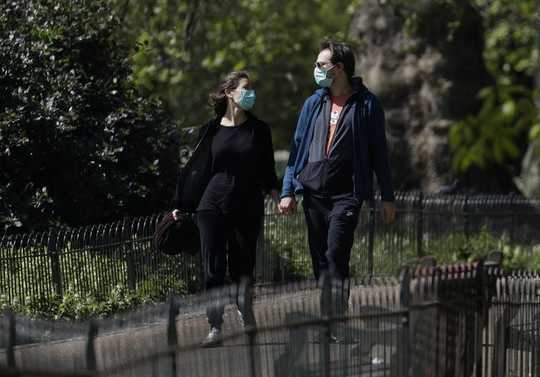 Short walks can boost the immune system and keep a person fit. AP Photo/Kirsty Wigglesworth
Short walks can boost the immune system and keep a person fit. AP Photo/Kirsty Wigglesworth
Recent Fitbit activity tracker data show a significant drop in physical activity worldwide that corresponds with the onset of the COVID-19 crisis. In the United States, physical activity has fallen by 12%.
Even before the COVID-19 pandemic, fewer than a quarter of Americans were getting the recommended amount of exercise.
I’m an activity expert, and I am concerned how this reduction in physical activity may impact our overall health and well-being.
Some of the drop in physical activity is due to temporary fitness center closings and stay-at-home guidelines. However, even people who don’t typically work out may have a reduction in activity because they are walking less to do everyday tasks and spending more time in front of a computer. These decreases in activity may add to the health concerns resulting from COVID-19.
Get The Latest By Email
Because of this, my colleagues and I want to use our expertise in physical activity promotion and obesity treatment and prevention to help individuals cope with the challenges resulting from this global pandemic.
It’s important to move
Prior to the pandemic, there had been concern about weight gain and the high prevalence of obesity in the United States and on a global scale.
This is important because obesity has recently been identified as a risk factor for COVID-19 complications. Evidence has also shown that disruption in regular exercise can lead to increases in depressive symptoms.
For an individual who is not a regular exerciser, adding periods of activity throughout the day may have mood enhancing effects. Short activity breaks throughout the workday can enhance emotional well-being.
Possibly most important is that physical activity can enhance immune function. This immune system boost may even occur in older people who are especially at risk for dying from COVID-19.
The argument is there to exercise more, but the reality is that many people are now doing less.
Activity over exercise
By definition, exercise is structured and planned.
The lack of planning and structure in our lives during this period of social distancing is likely contributing to the overall reduction in our activity levels.
Many people have been taught that exercise has to be intense and done for extended periods of time to make a difference, but U.S. government guidelines now suggest otherwise.
 The activity spectrum spans from ‘sleep’ to ‘vigorous activity.’ Renee J. Rogers, Author provided
The activity spectrum spans from ‘sleep’ to ‘vigorous activity.’ Renee J. Rogers, Author provided
Light activity breaks, that get the body moving without major increases in intensity, are often overlooked but helpful for breaking up sedentary time.
On the higher end of the spectrum is moderate to vigorous activity, which aligns more closely to what people classically consider to be exercise. Good news for us is that new evidence suggests that doing this type of activity in shorter bouts may provide the same benefits as long periods.
Building an active lifestyle at home
My team works every day to translate research into practice, so we have a strong track record of getting people to be active at home by starting at a low level and ramping up activity over time.
To start, take one-minute screen-time activity breaks, or a 5- to 10-minute brisk walk while social distancing. It all adds up.
Consider letting go of “all-or-nothing” exercise thinking.![]()
About The Author
Renee J. Rogers, Associate Professor of Health and Physical Activity - Programming Director, Pitt Healthy Lifestyle Institute, University of Pittsburgh
This article is republished from The Conversation under a Creative Commons license. Read the original article.
books_fitness







